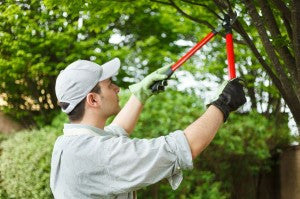
DIY Tree Pruning
Did you know that in most parts of the U.S., right now (late winter and into early spring) is a good time to get the pruning scissors out and trim those fruit trees you’ve got growing? If you’ve hesitated to tackle the tree pruning before, today we offer some basics of tree trimming to help you get your fruit trees in their best, most fruitful condition.
Why is Fruit-Tree Pruning Important?
Pruning your fruit trees offers the following benefits:
1. Pruning helps a tree to have a good basic structure to be able to bear the weight of its fruit and avoid breakage.
2. Pruning helps a tree produce more fruit, and the fruit of a well-pruned tree is often bigger and less likely to be infected by disease.
3. Pruning a tree helps it to be healthier and stronger overall and increases its longevity as a result.
4. Trees that have been pruned correctly are more aesthetically pleasing.
Some Tips on Technique
In order to avoid damaging the tree and making it more susceptible to disease, it’s very important to cut its limbs off in the right way. In other words, you can’t simply take the pruning scissors and chop limbs off helter-skelter. There is a technique to follow to minimize trauma and damage.
Most importantly, always make a clean cut and never let a limb tear when you are cutting it off. This can result in the tree becoming susceptible to fatal diseases. If you are cutting off a very large limb, most experts recommend first making a small cut at the bottom side of the limb and then finishing it off from the top to avoid tears.
It’s also vital to make your cut at the right point on the branch: the branch’s point of origin. If you cut too much (cutting into the trunk) or too little (leaving a stump) off the branch, your tree may start to decay. The sweet spot is usually said to be just outside of the branch collar so that the branch collar remains intact. (The branch collar is the thick ring around a limb where the limb meets the trunk or the branch it is attached to. On some trees, the branch collar is very visible, and on others it is harder to see.) One way to check your cuts is to see the following year if a donut shape has grown up around the wound. If it has, your cut was just right.
What Should Be Trimmed?
The most important pruning in a tree’s life happens in its first ten years of life. During these years, you are helping a tree to develop a good structure. If your tree is young, you will want to work on allowing its scaffolding branches (the limbs that are directly connected to the tree’s trunk) to have plenty of space to breathe and receive sunlight. Remove any branches that are contending with others for either space or light. Most fruit trees need about 6 to 12 inches of space between branches, so aim for this. If your tree is young, you also want to make sure it does not have any contending leaders. (The leader is the main branch that runs up the middle of the tree.) Most trees are designed to have only one leader so they don’t crack and break in half. If your tree looks like it is developing a second leader, this contending leader should be removed.
The pruning of more mature trees will be a lot lighter and will center mainly on getting rid of problem limbs, which we list below. Keep in mind that with mature trees, you are mostly aiming to make the tree more open and airy, so most of your work will be in the upper branches of the tree, thinning and allowing more light down to the bottom.
Problem limbs that should always be removed:
1. Remove watersprouts and suckers. Watersprouts are shoots that grow vertically out of other branches. They sprout up very quickly and are a waste of the tree’s energy. Suckers are shoots that grow up out of the ground along the base of the tree and are also weak limbs that are energy-wasters.
2. Remove any decayed or damaged limbs.
3. Remove branches that are growing in a downward direction.
4. Remove limbs that rub against or cross other limbs.
Tree pruning doesn’t have to be a task reserved for the pros. If you have a simple fruit tree that needs some maintenance, start with the basics. Even if you just trim a little, if you do it right, it will benefit your tree greatly and leave you with bigger, better fruit in the summer.
The post DIY Tree Pruning appeared first on Buy Emergency Food.
Tags
- All
- 25 year food
- 25 year shelf life food
- 72 hour kit
- Best food storage types
- Best long-term food storage
- Blizzard preparedness
- Budgeting
- canning
- Certified GMO-free Emergency foods
- Certified GMO-free foods
- Coffee
- Comparison of emergency food methods
- Composting tips
- Dangers of genetically modified foods
- dehydrated food
- Edible Wild Plants
- emergcy preparedness
- Emergency Cooking
- Emergency Food
- Emergency food Christmas gifts
- emergency food storage
- Emergency Food Supply
- Emergency food supply recommendations
- Emergency Planning
- Emergency Preparedness
- Emergency preparedness advice
- emergency preparednesss
- Emergency Supplies
- Emergency supplies checklist
- Emergency Survival
- emergency survival gear
- Emergency survival kit checklist
- Emergency Survival skills
- exercise
- Family emergency preparedness
- Family emergency preparedness plan
- Family Preparedness
- Food Storage
- Food storage 25 year shelf life
- Food storage amounts
- Food storage Christmas
- Food storage containers long term
- Food Storage Secrets
- Food storage serving size
- Food storage types compared
- freeze dried food
- Freeze dried food storage
- freeze dried meats
- Freeze-dried emergency food storage
- Fruit Trees
- Gardening
- Getting Started
- Gluten-free food Storage
- Gourmet emergency food
- Healthy food storage
- How much emergency food to store
- Improved emergency preparedness
- Jared Markin
- Jared Matkin
- Legacy Premium
- Lessons learned from Hurricane Sandy
- Lessons learned from natural disasters
- long-term food storage
- Long-term Food Storage Guidelines
- Long-term Food Storage tips
- Long-term water storage
- Mental Emergency Preparedness
- Mental toughness
- Money-saving tips
- Natural disaster planning
- Natural Disasters
- Perfect Christmas gifts
- Pet Emergency preparedness checklist
- Pet Emergency preparedness kit
- Pet Emergency Survival tips
- Pets and Emergency Preparedness
- Plant Foraging
- portable solar panels
- portable solar power
- portable water filters
- protein drinks
- Risk of genetic modification
- Seed saving and storage
- Seed saving guide
- Self-reliance
- Self-reliant practices
- Shelf Life
- Solar Cooking
- Solar Ovens
- Special Dietary needs
- Stranded in a car in a blizzard
- Survival food
- Survival Gear
- survival kit
- Survival kits
- Survival Ovens
- Survival Skills
- survivalist gear
- suvival kit
- Tree Pruning tips
- Tree Trimming basics
- unique ideas
- water bottle with filter
- water filter
- water filter straw
- water filters
- Water Filtration
- water pitcher with filter
- water pitchers with filters
- Water purification
- Wild Food Foraging
- Winter composting
- Winter driving
- Winter preparedness tips
- Winter storm preparedness tips
- Winter Survival








